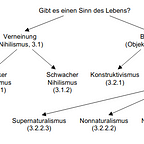What Utilitarian Jeremy Bentham Intended For His Body After Death
“How Can My Body Be Useful After Death?”
--
oil on canvas, exhibited 1829
Jeremy Bentham (1748–1832) was an English philosopher, and he’s regarded as the founder of modern utilitarianism.
Bentham had in many aspects modern views, for example, he advocated equal rights for men and women, the abolition of slavery, decriminalizing homosexuality, and animal rights.
What’s utilitarianism?
It’s a consequentialist ethical theory which considers an action moral when the consequences of the action add up to the overall utility, i.e., the overall happiness of all people affected by the action.
The greatest happiness principle, meant to declare the idea of moral actions, “is the greatest happiness of the greatest number that is the measure of right and wrong.”
Bentham, also known as the father of utilitarianism, thought about how he can contribute to overall happiness not only during his life but also after his death. When Bentham was 21 years old, he wrote a will leaving his body for dissection.
But that’s not the end of the story: He had a somewhat strange and unique idea: the auto-icon. Before his death in 1832, the philosopher left careful instructions for his body’s dissection and its preservation afterward.
He intended his skeleton padded out with hay, get dressed in his usual clothes, sat on a chair, and his actual head preserved through mummification. But the mummification process, based on a technique from indigenous people of New Zealand, left the head looking horrible, with dried and dark skin.
Therefore, the auto-icon was given a wax head and placed in a wooden cabinet, the auto-icon was acquired by University College London in 1850.
At that time, the philosopher’s last wishes were controversial. But his reasons are philosophically grounded: Bentham wrote a letter to Home Secretary Robert Peel that lobbied for anatomical dissection, explaining that he renders his corpse an instrument of utility and happiness, “I shall at least be not altogether useless after my death.”
But he doesn’t elaborate on what this usefulness consists of. This leaves room for speculations:
Although some people might attribute the auto-icon to Bentham’s egocentricity, it’s very probable that in the nineteenth century, the auto-icon might have helped normalize anatomical dissection.
Well, but how can dissection contribute to humanity’s overall happiness? Ross Harrison, an American biologist and anatomist explained it best:
“Utility, or happiness, depended upon health; health depended upon medical care; which depended upon medical knowledge; which depended upon dissection.”
The letter did not reveal much about the reasons that drove Bentham to this decision. But there’s more he wrote about it; i.e., an unpublished treatise titled “Auto-Icon; or, Farther Uses of the Dead to the Living.”
In this, he describes his reasons for turning himself into a well-preserved corpse.
„I have disposed of my own body after death. By that disposal I shall have made to the fund of human happiness a contribution, more or less considerable.”
In summary, his reasons are merely philosophical:
- to give his body to dissection because that’s the most useful thing to do; he believed it would increase the utility for humans the most
- with that, he hoped to encourage others to give their body to dissection
- the wish to contribute to the utility of humanity is based on his strong belief in utilitarianism
- he wanted to be a reminder that it is possible to live an utilitarian life
Utilitarianism is also nowadays a widely discussed ethical theory. And its personification is still exhibited as an auto-icon at the University College London, at the end of the South Cloisters in the main building of the college.
